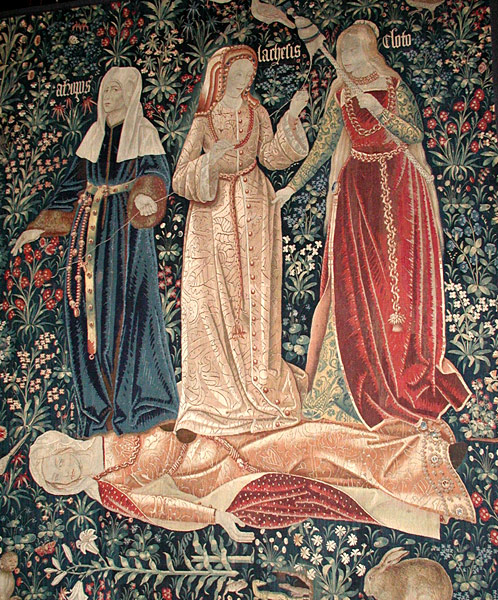Lachesis (mythology) on:
[Wikipedia]
[Google]
[Amazon]
 Lachesis ( ; grc, ќЫќђѕЗќµѕГќєѕВ, L√°khesis, disposer of lots; from , 'to obtain by lot, by fate, or by the will of the gods'), in
Lachesis ( ; grc, ќЫќђѕЗќµѕГќєѕВ, L√°khesis, disposer of lots; from , 'to obtain by lot, by fate, or by the will of the gods'), in
 Lachesis ( ; grc, ќЫќђѕЗќµѕГќєѕВ, L√°khesis, disposer of lots; from , 'to obtain by lot, by fate, or by the will of the gods'), in
Lachesis ( ; grc, ќЫќђѕЗќµѕГќєѕВ, L√°khesis, disposer of lots; from , 'to obtain by lot, by fate, or by the will of the gods'), in ancient Greek religion
Religious practices in ancient Greece encompassed a collection of beliefs, rituals, and mythology, in the form of both popular public religion and cult practices. The application of the modern concept of "religion" to ancient cultures has been ...
, was the second of the Three Fates, or Moirai
In ancient Greek religion and mythology, the Moirai (, also spelled Moirae or M≈Уr√¶; grc, ќЬќњбњЦѕБќ±ќє, "lots, destinies, apportioners"), often known in English as the Fates ( la, Fata, Fata, -orum (n)=), were the personifications of fat ...
; the others were her sisters, Clotho
Clotho (; el, ќЪќїѕЙќЄѕО) is a mythological figure. She is the youngest of the Three Fates or Moirai who spins the thread of human life; the other two draw out ( Lachesis) and cut (Atropos) in ancient Greek mythology. Her Roman equivalent is ...
and Atropos
Atropos (; grc, бЉМѕДѕБќњѕАќњѕВ "without turn") or Aisa, in Greek mythology, was one of the three Moirai, goddesses of fate and destiny. Her Roman equivalent was Morta.
Atropos was the oldest of the Three Fates, and was known as "the Infle ...
. Normally seen clothed in white, Lachesis is the measurer of the thread spun on Clotho's spindle, and in some texts, determines Destiny, or thread of life. Her Roman equivalent was Decima. Lachesis was the apportioner, deciding how much time for life was to be allowed for each person or being. She measured the thread of life with her rod. She is also said to choose a person's destiny after a thread was measured. In mythology, it is said that she appears with her sisters within three days of a baby's birth to decide the baby's fate.
Origin
According toHesiod
Hesiod (; grc-gre, бЉ©ѕГќѓќњќіќњѕВ ''HƒУs√≠odos'') was an ancient Greek poet generally thought to have been active between 750 and 650 BC, around the same time as Homer. He is generally regarded by western authors as 'the first written poet i ...
's ''Theogony
The ''Theogony'' (, , , i.e. "the genealogy or birth of the gods") is a poem by Hesiod (8thвАУ7th century BC) describing the origins and genealogies of the Greek gods, composed . It is written in the Epic dialect of Ancient Greek and contain ...
'', Lachesis and her sisters were the daughters of Erebus
In Greek mythology, Erebus (; grc, бЉЬѕБќµќ≤ќњѕВ, √Йrebos, "deep darkness, shadow".), or Erebos, is the personification of darkness and one of the primordial deities. Hesiod's ''Theogony'' identifies him as one of the first five beings in exis ...
(Darkness) and Nyx (Night), though later in the same work (ll. 901-906) they are said to have been born of Zeus
Zeus or , , ; grc, ќФбњРѕМѕВ, ''Di√≥s'', label=Genitive case, genitive Aeolic Greek, Boeotian Aeolic and Doric Greek#Laconian, Laconian grc-dor, ќФќµѕНѕВ, De√Їs ; grc, ќФќ≠ќњѕВ, ''D√©os'', label=Genitive case, genitive el, ќФќѓќ±ѕВ, ''D√ ...
and Themis
In Greek mythology and religion, Themis (; grc, ќШќ≠ќЉќєѕВ, Themis, justice, law, custom) is one of the twelve Titan children of Gaia and Uranus, and the second wife of Zeus. She is the goddess and personification of justice, divine order, fai ...
. Lachesis is also mentioned in the tenth book of the ''Republic'' of Plato as the daughter of Necessity
Necessary or necessity may refer to:
* Need
** An action somebody may feel they must do
** An important task or essential thing to do at a particular time or by a particular moment
* Necessary and sufficient condition, in logic, something that i ...
. She instructs the souls who are about to choose their next life, assign them lots, and presents them all of the kinds, human and animal, from which they may choose their next life.
Namesake
''Lachesis
Lachesis ( ; grc, ќЫќђѕЗќµѕГќєѕВ, L√°khesis, disposer of lots; from , 'to obtain by lot, by fate, or by the will of the gods'), in ancient Greek religion, was the second of the Three Fates, or Moirai; the others were her sisters, Clotho and ...
'' is a genus of pit vipers sometimes called bushmasters.Beolens, Bo; Watkins, Michael; Grayson, Michael (2011). ''The Eponym Dictionary of Reptiles''. Baltimore: Johns Hopkins University Press. xiii + 296 pp. . ("Lachesis", p. 149). It includes the largest venomous snake in the Western Hemisphere.
References
Further reading
*Thomas Blisniewski: ''Kinder der dunkelen Nacht. Die Ikonographie der Parzen vom späten Mittelalter bis zum späten XVIII.'' Jahrhundert. Dissertation Cologne 1992. Berlin 1992.External links
* * * {{DEFAULTSORT:Lachesis (Mythology) Moirai Greek goddesses Children of Zeus Time and fate goddesses Textiles in folklore Personifications in Greek mythology id:Moirai#Lakhesis